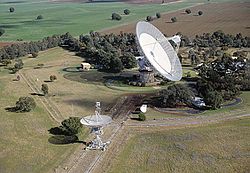Parkes Observatory
 The Parkes Observatory in New South Wales, Australia | |||
| Organization | Australia Telescope National Facility | ||
|---|---|---|---|
| Location | Parkes, NSW, Australia | ||
| Coordinates | 32°59′59.8″S 148°15′44.3″E / 32.999944°S 148.262306°E | ||
| Website | www.parkes.atnf.csiro.au | ||
| Telescopes | |||
| |||
| | |||
The Parkes Observatory is a radio telescope observatory, 20 kilometres north of the town of Parkes, New South Wales, Australia. It was one of several radio antennas used to receive images of the Apollo 11 moon landing in July 1969.
The radio telescope
The Parkes Radiothermal Telescope, completed in 1961, was the brainchild of E.G. (Taffy) Bowen, chief of the CSIRO's Radiophysics Laboratory. During the Second World War, he had worked on radar development in America and had made some powerful friends in the scientific community. Calling on this old boy network, he persuaded two philanthropic organisations, the Carnegie Corporation and the Rockefeller Foundation to fund half the cost of the telescope. It was this recognition and key financial support from America that persuaded then Prime Minister Robert Menzies to agree to fund the rest of the project.[1]
The primary observing instrument is the 64-metre movable dish telescope, second largest in the Southern Hemisphere, and one of the first large movable dishes in the world (DSS-43 at Tidbinbilla was extended from 64 m to 70 m in 1987, surpassing Parkes).[2] After its completion it has operated almost continuously to the present day. The dish surface was physically upgraded by adding smooth metal plates to the central part to provide focusing capability for centimetre and millimetre length microwaves. The outer part of the dish remains a fine metal mesh, creating its distinctive two-tone appearance.
The 18m dish antenna in the foreground of the photo was transferred from the Fleurs Observatory (Mills Cross) in 1963. It was used as a transmit uplink antenna in the Apollo program and has been abandoned since the early 1980s.
The telescope has an altazimuth mount. It is guided by a small mock-telescope placed within the structure at the same rotational axes as the dish, but with an equatorial mount. The two are dynamically locked when tracking an astronomical object by a laser guiding system. This primary-secondary approach was designed by Barnes Wallis.
The success of the Parkes telescope led NASA to copy the basic design in their Deep Space Network, with matching 64 m dishes built at Goldstone, Madrid and Tidbinbilla.
The receiving cabin is located at the focus of the parabolic dish, supported by three struts 27 metres above the dish. The cabin contains multiple radio and microwave detectors, which can be switched into the focus beam for different science observations.
The observatory is a part of the Australia Telescope National Facility network of radio telescopes. The 64m dish is frequently operated together with the Australia Telescope Compact Array at Narrabri and a single dish at Mopra, to form a very long baseline interferometry array.
During the Apollo missions to the moon, the Parkes Observatory was used to relay communication and telemetry signals to NASA, providing coverage for when the moon was on the Australian side of the Earth.[3]
The observatory has remained involved in tracking numerous space missions up to the present day, including the Mariner 2, Mariner 4, Voyager, Giotto, Galileo and Cassini-Huygens probes. It is also a major world centre for research into pulsars, with more than half of those currently known today discovered at the Parkes Observatory. Between 1997 and 2002 it conducted the HIPASS neutral hydrogen survey, the largest blind survey for galaxies in the neutral hydrogen line to date.

The observatory and telescope were featured in the 2000 film The Dish, a fictionalised account of the observatory's involvement with the Apollo 11 moon landing.
Apollo 11 broadcast
Contrary to popular belief generated by the film The Dish, the Parkes Observatory was not the first station to broadcast images from the Apollo 11 moon landing. The Goldstone Deep Space Communications Complex in California was initially used to receive the signals, but, due to problems experienced at the Goldstone complex, NASA switched the main feed to the Honeysuckle Creek station outside Canberra. Honeysuckle Creek transmitted the images for about 10 minutes until NASA switched the feed to Parkes. Due to the impressive quality of the images being received, the feed stayed with Parkes and "The Dish" transmitted the remaining footage to the rest of the world. Parkes' control name was PKS. [4]

